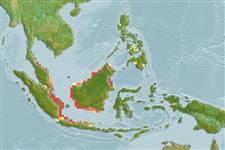Environment: milieu / climate zone / depth range / distribution range
Ecología
marino; agua dulce; salobre demersal. Tropical
Asia: Cambodia and Thailand to Indonesia.
Tamaño / Peso / Age
Maturity: Lm ? range ? - ? cm
Max length : 14.0 cm SL macho / no sexado; (Ref. 12693)
Found along the bottom in flowing water and reportedly also in brackish water of the lower courses of rivers. Feeds primarily on benthic invertebrates (Ref. 12693).
Life cycle and mating behavior
Maturities | Reproducción | Spawnings | Egg(s) | Fecundities | Larva
Roberts, T.R., 1989. The freshwater fishes of Western Borneo (Kalimantan Barat, Indonesia). Mem. Calif. Acad. Sci. 14:210 p. (Ref. 2091)
IUCN Red List Status (Ref. 130435)
Threat to humans
Harmless
Human uses
Herramientas
Special reports
Download XML
Fuentes de Internet
Estimates based on models
Preferred temperature (Ref.
123201): 28.2 - 29.2, mean 28.8 °C (based on 338 cells).
Phylogenetic diversity index (Ref.
82804): PD
50 = 0.7500 [Uniqueness, from 0.5 = low to 2.0 = high].
Bayesian length-weight: a=0.00977 (0.00473 - 0.02021), b=3.07 (2.90 - 3.24), in cm total length, based on LWR estimates for this (Sub)family-body shape (Ref.
93245).
Nivel trófico (Ref.
69278): 3.5 ±0.37 se; based on food items.
Resiliencia (Ref.
120179): Alto, población duplicada en un tiempo mínimo inferior a 15 meses (Preliminary K or Fecundity.).
Fishing Vulnerability (Ref.
59153): Low vulnerability (10 of 100).
